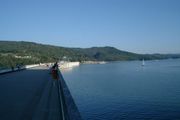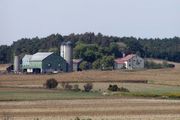Water resources
2007 Schools Wikipedia Selection. Related subjects: Geology and geophysics
Water resources are sources of water that are useful or potentially useful to humans. It is important because it is needed for life to exist. Many uses of water include agricultural, industrial, household, recreational and environmental activities. Virtually all of these human uses require fresh water. Only 2.5% of water on the Earth is fresh water, and over two thirds of this is frozen in glaciers and polar ice caps. Water demand already exceeds supply in many parts of the world, and many more areas are expected to experience this imbalance in the near future. The framework for allocating water resources to water users (where such a framework exists) is known as water rights.
Water and conflict
Throughout history, water resources have occasionally been the source of conflict. Examples include:
- Well poisoning
- Privatization and Water Pricing in India ,
- Privatization and Water Pricing protests in Cochabamba, Bolivia in 2000
Nevertheless, some claim that the issue does not get the attention it deserves, in particular with regard to security.
Threats to fresh water
There are many things that are a threat to the Earths fresh water supply. Here are a few of them.
Climate change
Climate change will have significant impacts on water resources around the world because of the close connections between the climate and hydrologic cycle. Rising temperatures will increase evaporation and lead to increases in precipitation, though there will be regional variations in rainfall. Overall, the global supply of freshwater will increase. Both droughts and floods may become more frequent in different regions at different times, and dramatic changes in snowfall and snowmelt are expected in mountainous areas. Higher temperatures will also affect water quality in ways that are not well understood. Possible impacts include increased eutrophication. Climate change could also mean an increase in demand for farm irrigation, garden sprinklers, and perhaps even swimming pools.
Depletion of aquifers
Since competition for water is growing, underground aquifers are becoming depleted. This is mainly due to irrigation by groundwater. Millions of small pumps are currently taking water out of aquifers to irrigate crops. Irrigation in dry areas such as India is supplied by groundwater.
Pollution and water protection
Water pollution is one of the many concerns of the world today. World governments have strived to find solutions to eliminate this problem. Many programs strive to protect our water resources. They are usually funded by donations from generous people.
Uses of fresh water
Uses of fresh water can be categorized as consumptive and non-consumptive (sometimes called "renewable"). A use of water is consumptive if that water is not immediately available for another use. Losses to sub-surface seepage and evaporation are considered consumptive, as is water incorporated into a product (such as farm produce). Water that can be treated and returned as surface water, such as sewage, is generally considered non-consumptive if that water can be put to additional use.
Agricultural
It is estimated that 70% of world-wide water use is for irrigation. In some areas of the world irrigation is necessary to grow any crop at all, in other areas it permits more profitable crops to be grown or enhances crop yield. Various irrigation methods involve different trade-offs between crop yield, water consumption and capital cost of equipment and structures. Irrigation methods such as most furrow and overhead sprinkler irrigation are usually less expensive but also less efficient, because much of the water evaporates or runs off. More efficient irrigation methods include drip or trickle irrigation, surge irrigation, and some types of sprinkler systems where the sprinklers are operated near ground level. These types of systems, while more expensive, can minimize runoff and evaporation. Any system that is improperly managed can be wasteful. Another trade-off that is often insufficiently considered is salinization of sub-surface water.
Aquaculture is a small but growing agricultural use of water. Freshwater commercial fisheries may also be considered as agricultural uses of water, but have generally been assigned a lower priority than irrigation (see Aral Sea and Pyramid Lake).
As global populations grow, and as demand for food increases in a world with a fixed water supply, there are efforts underway to learn how to produce more food with less water, through improvements in irrigation methods and technologies, agricultural water management, crop types, and water monitoring.
Industrial

It is estimated that 15% of world-wide water use is industrial. Major industrial users include power plants, which use water for cooling or as a power source (i.e. hydroelectric plants), ore and oil refineries, which use water in chemical processes, and manufacturing plants, which use water as a solvent.
The portion of industrial water usage that is consumptive varies widely, but as a whole is lower than agricultural use.
Household
It is estimated that 15% of world-wide water use is for household purposes. These include drinking water, bathing, cooking, sanitation, and gardening. Basic household water requirements have been estimated by Peter Gleick at around 50 liters per person per day, excluding water for gardens.
Most household water is treated and returned to surface water systems, with the exception of water used for landscapes. Household water use is therefore less consumptive than agricultural or industrial uses.
Recreation
Water has a lot of recreational value.
Recreational water use is a very small but growing percentage of total water use. Recreational water use is mostly tied to reservoirs. If a reservoir is kept fuller than it would otherwise be for recreation, then the water retained could be categorized as recreational usage. Release of water from a few reservoirs is also timed to enhance whitewater boating, which also could be considered a recreational usage. Other examples are anglers, water skiers, nature enthusiasts and swimmers.
Recreational usage is non-consumptive. However it may reduce the availability of water for other users at specific times and places. For example, water retained in a reservoir to allow boating in the late summer is not available to farmers during the spring planting season. Water released for whitewater rafting may not be available for hydroelectric generation during the time of peak electrical demand.
Environmental
Explicit environmental water use is also a very small but growing percentage of total water use. Environmental water usage includes artificial wetlands, artificial lakes intended to create wildlife habitat, fish ladders around dams, and water releases from reservoirs timed to help fish spawn.
Like recreational usage, environmental usage is non-consumptive but may reduce the availability of water for other users at specific times and places. For example, water release from a reservoir to help fish spawn may not be available to farms upstream.
World water supply and distribution
Food and water are two basic human needs. As the picture shows, in 2025, water shortages will be more prevalent among poorer countries where resources are limited and population growth is rapid, such as the Middle East, Africa, and parts of Asia. By 2025, large urban and peri-urban areas will require new infrastructure to provide safe water and adequate sanitation. This suggests growing conflicts with agricultural water users, who currently consume the majority of the water used by humans.
Generally speaking the more developed countries of North America, Europe and Russia will not see a serious threat to water supply by the year 2025, not only because of their relative wealth, but more importantly their populations will be better aligned with available water resources. North Africa, the Middle East, South Africa and northern China will face very severe water shortages due to physical scarcity and a condition of overpopulation relative to their carrying capacity with respect to water supply. Most of South America, Sub-Saharan Africa, Southern China and India will face water supply shortages by 2025; for these latter regions the causes of scarcity will be economic constraints to developing safe drinking water, as well as excessive population growth.





